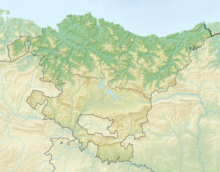| San Adrian tunnel | |
|---|---|
 Northern access to the San Adrian tunnel | |
| Location | Aizkorri-Aratz Natural Park, Gipuzkoa, Basque Country, Spain |
| Coordinates | 42°56′07″N 2°18′55″W / 42.93528°N 2.31528°W |
| Entrances | 2 |
| Type | Cultural |
| Criteria | ii, iv, vi |
| Designated | 2015 |
| Part of | Routes of Santiago de Compostela: Camino Francés and Routes of Northern Spain |
| Reference no. | 669bis-017 |
| Region | Europe and North America |

The San Adrian tunnel or Lizarrate[1] represents the most outstanding milestone in the historic inland Basque route of the Way of St. James. It consists of a natural cave carved by water erosion in the rock (called Lizarrate, arguably stemming from "leize arrate", 'the stone gate of the cave') with an opening on either side north and south; it also holds a hermitage inside. The tunnel provides a natural passage dividing the provinces of Gipuzkoa and Álava/Araba (the actual borderline locating at the Alto de la Horca).
The Spanish-Basque linguistic boundary of the twentieth century was established in this area, the next village south, Zalduondo, having been predominantly Spanish speaking during that period. Nowadays many hikers cross the tunnel in order to gain access to the nearby peaks, forests and grazing fields, namely Aratz, Aizkorri and Urbia.
- ^ (in Spanish) Luis Peña Basurto: "Lizarrate," Auñamendi Eusko Entziklopedia.

